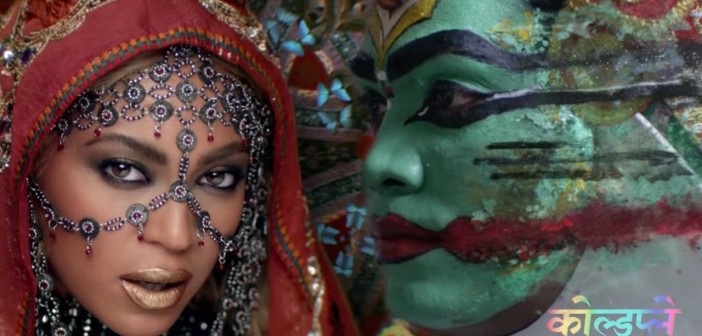“Cultural appropriation typically involves members of a dominant group exploiting the culture of less privileged groups — often with little understanding of the latter’s history, experience, and traditions.”
The term ‘cultural appropriation’ is taking the world by storm, and rightfully so. We hear the phrase on the internet, in the news, and even out of the mouths of celebrities, namely Hunger Games actress Amandla Stenberg and Grammy Award winner Nicki Minaj. So with an anti-cultural appropriation movement on the rise, it is important for people of all races and ethnicities to have a thorough, mutual understanding of what is and what is not an act of appropriating culture.
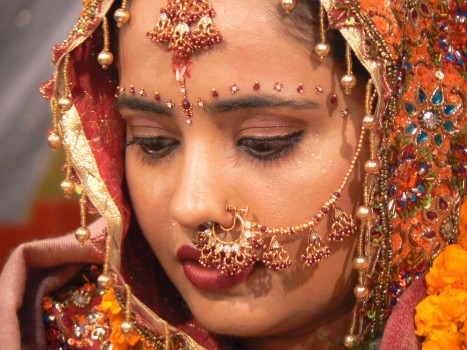
An Indian woman wearing a nose chain, a major aspect of gothic fashion. Nose chains have become one of the various aspects of Indian culture commonly appropriated by Western culture.
What is it and why does it matter?
Cultural appropriation can be more pointedly defined as taking intellectual property, cultural expressions, traditional knowledge, or artifacts from another culture without permission. This includes, but is not limited to dance, fashion, music, language, mythology, cuisine, and religious symbols. Appropriating cultures can be harmful in all cases, but is most detrimental when the source community is a minority group. These minorities are often victim to oppression and exploitation by the same group that is that is appropriating their culture. This becomes especially harmful when the object of appropriation is particularly sensitive such as a sacred object. Although it could be thought as complimentary to take inspiration from another group, without the proper credit and intent, the minority group is robbed of the tribute they deserve.
As forms of art, music, and fashion are being deemed as incoming and innovative rather than inspired by another culture, the dominant group becomes associated with products that originated with the minority. The result? “The dominant group is deemed innovative and edgy, while the disadvantaged groups they ‘borrow’ from continue to face negative stereotypes that imply they’re lacking in intelligence and creativity.” Basically, cultural appropriation is the entitlement to steal aspects of another person’s identity without having to understand or even appreciate them.
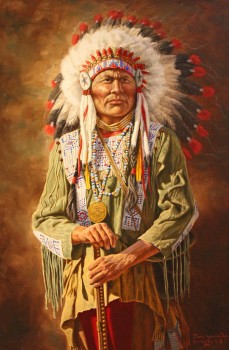
A portrait of a Native American chief wearing a traditional head-dress.
From Native American head-dresses to twerking, it’s difficult to wage what truly is an act of cultural appropriation and what is an appropriate culturally inspired act. In order for us to truly progress as a country, and in the bigger picture, internationally, we must first come to a consensus on where the line is drawn between an appropriate influence by and appreciation of another country, and blatantly disrespecting and claiming credit for any aspect of another culture. So, where is the line drawn from simply being inspired by the salad bowl that is the United States and appropriating someone else’s culture? This mass inspiration by other cultures doesn’t necessarily have to be a bad thing—it’s potentially incredibly positive, if done respectfully.
Where is it in our daily lives?
Although cultural appropriation has been an existing issue since the 1950s origination of rock ‘n’ roll, and very likely long before, the topic has recently skyrocketed in social importance due to the prevalence of the internet. People of all races and ethnicities are beginning to be vocal about their own experiences with cultural appropriation and it’s affect on them personally. Together, these people are using the power of the internet to call out appropriation when they see it and, in most cases, to educate others on what exactly is wrong with the act at hand.
Along with the surplus of rational people fighting for the cause on the internet unfortunately are many spewing out hate, using cultural appropriation as an excuse, having not a solid understanding on the concept themselves. In addition to providing a world of knowledge, the Internet also brings a world of outrage and oversensitivity. In the past several years, there have been numerous occasions where people have used the internet to accurately and inaccurately call others—mainly celebrities—out for cultural appropriation. Recent cultural appropriation controversies that had the internet stirring include the Kardashian “boxer braids” fiasco, Katy Perry performing “Unconditionally” in Geisha attire, Miley Cyrus claiming twerking as her own, and recent fashion trends in general.
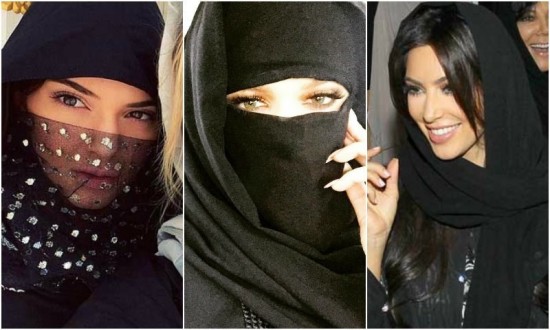
Kendall, Khloe, and Kim Kardashian, three of the most followed celebrities on social media, wearing burkas, another commonly appropriated cultural fashion.
The Kardashians have quite the knack for receiving internet scrutiny on their culturally influenced fashions, but Kim’s “boxer braids” take the cake for the most blatant act of cultural appropriation. Eager to be deemed a trendsetter, Kardashian posted a photo of herself wearing cornrows in her hair, and re-named the style “boxer braids”, rather than referencing “cornrows”, giving credit to the African culture from which the style derived. The New York Post then proceeded to describe Sasha Obama’s hairstyle from the White House State Dinner as “boxer braids”, completely erasing the connection with her own ancestry. “When Black women have to fight for acceptance with the same styles a young white woman can be admired for, what message does that send to Black women and girls?”
In late 2013, Katy Perry opened up the American Music Awards with a performance of her song “Unconditionally” dressed as a Japanese Geisha. The act of dressing up as a Geisha in itself is not cultural appropriation, but Perry’s depiction of Japanese women fed into every negative stereotype in orbit. Her performance portrayed Japanese women as dainty, submissive, and demure, only further feeding into American stereotypes and fetishization of Asian women. Combined with lyrics to the song detailing complete and utter devotion to a man, Katy Perry gave the general public the perfect example of how not to portray another culture.
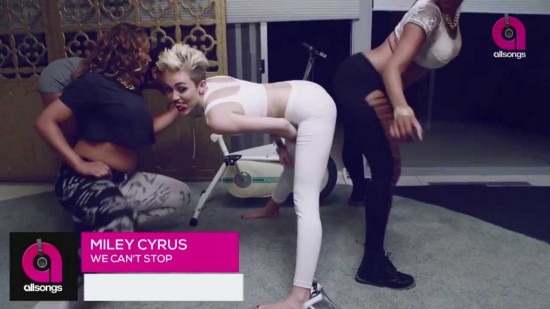
A screenshot of Miley Cyrus’ “We Can’t Stop” music video–one of the many examples of Cyrus appropriating culture.
One of the most famous faces of celebrity cultural appropriation is, of course, Miley Cyrus. Cyrus has famously appropriated black culture on numerous occasions, most including her appropriation of twerking, a historically black dance move. Along with the attempt to claim the dance move as her own, Cyrus is infamous for parading around black women as her background dancers, using them only as sexual objects and props for the show. “What would America be like if we loved black people as much as we love black culture?” asks Amandla Stenberg, Hunger Games actress, in a video monologue she posted discussing cultural appropriation. With celebrities continuing to glorify the violation of others’ cultures, we may never know such an America.
Celebrities aren’t the only people who participate in acts of cultural appropriation, although they do make great examples of right and wrong for the rest of the community. One of the big ways most people appropriate culture, sometimes without even knowing it, is by the clothes they wear. Fashion is supposed to be innovative, and innovation requires inspiration, but when a designer profits based off of designed adopted from Native women, for example, she is actually assisting in the cycle of unemployment for said Native women. By taking inspiration from Native American spirituality and life practices, or any other minority group for that matter, one also needs to hold themselves accountable to those communities, whether it be raising awareness, giving back, or showing some other adequate form of respect. Also, by refining our purchasing practices, we can be sure to only be making decisions that benefit and respect the culture from which it is derived.
What’s the difference between appreciating and appropriating?
It is very difficult with all the scrutiny on the internet, and no solid universal understanding of cultural appropriation, for people to be inspired by another’s culture without being accused of appropriation. Although each of the aforementioned situations were in fact examples of appropriating culture, there were several controversial moments on the internet recently where big names were accused of cultural appropriation, but were in fact demonstrating the proper way to be inspired by another culture.
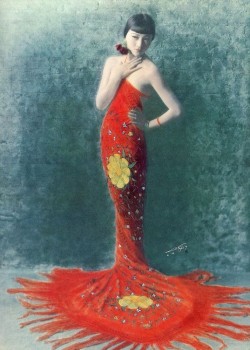
A modern Chinese couture gown with Imperial yellow flowers, the same shade as Rihanna’s 2015 Met Gala dress.
At the 2015 Met Gala, themed “China: Through the Looking Glass”, international pop-star Rihanna dazzled in an imperial yellow, Chinese couture gown. Not long after being named best dressed, the internet went wild with cultural appropriation accusations, claiming she was insulting the Chinese by wearing a shade that was once reserved for the Emperor. Many who disagree, however, have argued that in this age, an international pop-star’s status would meet that of an ancient Chinese emperor. Additionally, the fact that the designer of Rihanna’s dress is in fact a Beijing based Chinese couturier in itself shows that she is avoiding appropriating the Chinese culture; Guo Pei himself has said about the dress “it is my responsibility to let the world know China’s tradition and past, and to give the splendor of China a new expression.” Having international pop-star and style icon Rihanna show off the gown with such elegance is an impeccable way to turn the world’s attention to China’s culture.
Cultural appropriation is everywhere, but it’s not always as easy as choosing the correct designer to avoid disrespecting another’s culture. Yoga, an increasingly popular act in western civilization, was actually once banned in India as part of the characterization of Indian people as perverse heathens, and they were forced to conform to Western ways. It’s ironic that the same people who told them these acts were perverse are the people who are actively practicing today. “It can feel like a slap in the face to see carefree white people enjoy the practices your ancestors were penalized for. Yoga is being divided from its true roots and purpose, and from the people who had to fought to keep it alive. That’s what the commercialization of yoga is doing to South Asian people today–increasing white people’s access, while continuing to take it away from people who had to fight to keep it alive in the first place.” It seems pointless to tell the millions of new people who have picked up this healthy habit to simply drop it, but it is important to comprehend and respect the history of a practice that so many enjoy but so few care to understand.
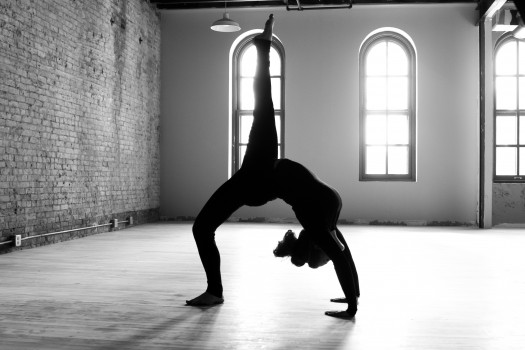
A westerner enjoying the practice of yoga. It would be difficult to stop all westerners from practicing, but educating yoga-lovers on the act’s history would aid in this massive cultural appropriation.
Finding a common understanding is a necessity, because while it is crucial that we learn to respect the cultures from which our fashions and practices derived, it is also important to understand that as citizens of an increasingly interconnected world, it is impossible to not extract aspects of other cultures into one’s own life. Although raising awareness about culture appropriation is nothing but beneficial to the further progression of the United States, the lack of a common understanding of what is and isn’t appropriate combined with the impassioned demand for cultural respect has led to internet bullying and even violence.
In a recent incident at San Francisco State University, an African-American campus employee is caught on tape physically harassing a caucasian student with dreadlocks, threatening to cut off his hair due to the fact that it is her culture. In no way, shape, or form is this girl in the wrong for expressing her feelings on the appropriation of her culture, but this act was fueled by anger and will not produce any positive results. The increasingly popular conversation of cultural appropriation on the internet and around the world means nothing if it fuels hatred rather than inspires the desire to educate others. When asked specifically about white people sporting dreadlocks, Gene Demby of NPR’s Code Switch blog on race, ethnicity, and culture simply states the importance of “distinguishing between the appreciators and the appropriators”.
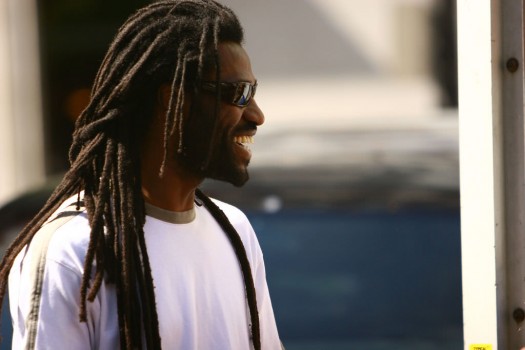
A classic example of dreadlocks, originating from the Rastafarians from Jamaica.
So now what?
The fact of the matter is, cultural appropriation is an incredibly difficult thing to identify due to the fact that emotions and intentions, two things not easily waged from afar, are huge contributing factors on either side of the equation. So here lies the big question: is there a compromise that people don’t feel their cultures are being disrespected and under-appreciated, but simultaneously aren’t limited to emulating the lives of their ancestors? Can we sport the fashions, listen to the music, and partake in the dance moves of another culture if we learn to give credit where credit is due?
As a caucasian female living in the culturally diverse United States, I am genuinely inspired and in awe of the cultures that surround me on a regular basis, and even more so the cultures that I never get the chance to interact with; as a caucasian female living in the culturally diverse United States, I understand that emulating aspects of these cultures without showing the proper respect can be wildly insulting, and even damaging to the civilization from which these practices and qualities derive. I want to be aware, I want to respect others, and I want to grow—and you should too.
When it comes to identifying cultural appropriation, in yourself and in others, it’s all about context. If there is something you find inspiring about another culture, and you want to work it into your own life, do your research—learn the cultural significance. Many cultures use a variety of tools ranging from dance to fashion to symbolize status, life experiences, lost love ones, etcetera. Understanding what message you may be putting across—or depreciating, is a great first step to make the right decision as to whether or not you are appropriating culture.

